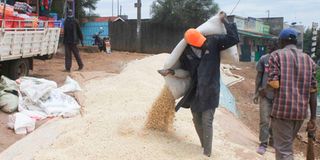Maize prices to fall as harvesting starts

Workers spread maize to dry in Elburgon in October 2021.
Maize farmers in some parts of the country have began to harvest their produce, raising hope that the price of the commodity would decline in the coming weeks.
Betty Sang, a small-scale farmer in Kimargis village in Bomet County, said they have been harvesting for the last two weeks.
“The maize was ready for harvest since early August. Many farmers have been harvesting though recent elections disrupted the process. Farmers in Narok are also harvesting," said Sang, who grows the crop on an acre.
With sustained harvest, the cost of a 2kg tin of maize is expected to reduce from Sh200 to Sh160.
A 90kg bag of maze is currently going for an average of Sh6,000, a slight decline from Sh6,200. Farmers in Uasin Gishu and Trans Nzoia counties are, however, yet to start harvesting.
Also Read: A hungry nation
Thomas Korgoren, a maize farmer who doubles up as a trader, said they are currently getting supplies from Narok and Tanzania through Isebania border.
But in Bungoma, Bruce Wafula, a maize grower, said some farmers have began to harvest.
"Farmers have harvested most of their produce but there was a decline due to challenges arising from fertiliser shortage. We are preparing for the second season and we are optimistic the situation will improve,” said the farmer.
Dr Mary Nzomo, Trans Nzoia Agriculture executive, said that they forecast production of maize for the region to stand at 5.27 million 90kg bags against a target of 5.6 million bags.
She attributed the decline to non-optimal use of fertiliser during planting due to high cost.
“Most farmers, therefore, did not achieve the optimal application rates and this will definitely lead to low productivity,” she said.
She added that there has been infestation of a combination of African armyworm and fall armyworm, what will also push down the yields.
‘‘Weather-related factors such as dry spell led to poor germination. Excess rains later in the season lead to water logging in some areas, lodging and leaching of nutrients compromising yields,” she observed.
It is currently raining in the county and the executive fears that if the wet weather persists, rotting of early-planted maize and early-maturing varieties would occasion high post-harvest losses.
With the ongoing harvest in various parts of the country, experts note that this will help bring down prices but only in the short-term due to anticipated decline in production.
Dr Timothy Njagi, a principal researcher at the Tegemeo Institute of Agricultural Policy, observed that the maize cultivated in the North Rift accounts for 50 per cent that is expected in the next two months while the two seasons from the South and Central Rift, Lower Eastern and parts of Western constitute 30 and 40 per cent of the total annual production respectively.
“The harvests will certainly lead to stabilisation of market prices of the commodity. However, we expect that there will be a drop in maize harvest due to high cost of inputs,” he explains.
With a good crop harvest of about 40 million bags, the country requires 10 per cent of maize imports to plug in the deficit, observes the expert.
According to him, elections had disrupted supply of the commodity, especially in urban areas.
“We expect importation to go beyond 10 per cent because of declined production. What we need is a good balance of imports to keep prices stable," he said.
Maize production in 2020 stood at 42.1 million bags, down from 44 million in 2019. The country’s maize flour production over the last five years has averaged 2.8 million tonnes annually.
According to the Kenya National Bureau of Statistics, over the last five years, Kenya has imported an average of 295,092 tonnes of maize annually.
Dr Njagi hopes that the recent maize subsidy was efficiently managed to ensure that no miller or trader took advantage to import excess maize.
“Currently, there is no data on the amount of the grains imported into the country after the government allowed duty-free importation of the commodity to selected millers,” observes the expert.





